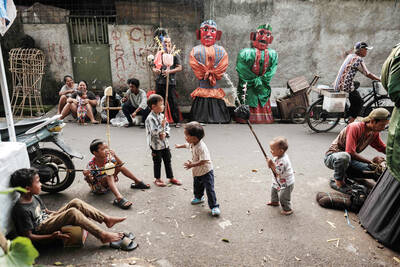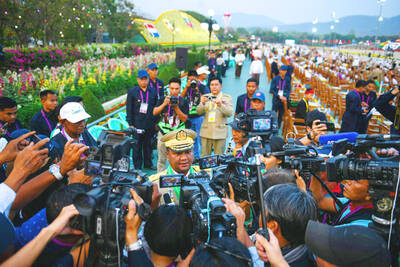It was a symbol of the Mexico City landscape, zooming, honking and fuming in the mega-capital’s infamously dense traffic. However, the beloved Volkswagen Beetle is nearly extinct, a victim of anti-pollution campaigns.
A few vochos, as the curvy car is known in Mexico, can still be spotted occasionally in the city’s chaotic streets, while so-called Vochomania clubs of collectors try to keep it alive.
However, the once ubiquitous white and green — and later red and gold — Beetle taxis that clogged boulevards are gone from the metropolis, home to 20 million people and 4 million cars.
“We could have thought about keeping a few in the historic center to preserve the symbol, but it wasn’t meant to be,” said Rodrigo Diaz, an urban planning consultant who writes a blog on transport issues.
The unceremonious demise of the vocho is surprising for a country that has had a long love affair with the Beetle.
The “people’s car” born in Germany in the politically charged 1930s arrived in Mexico in 1954, where it became an instant hit.
Seen as affordable, easy to fix and a fun ride, Mexicans scooped up 50,000 Beetles in just one year. It was quickly adopted by taxi drivers and the Volkswagen was given the diminutive nickname, vocho.
“In case of a breakdown, you could replace the fan belt with panty hose,” said Ricardo, a nostalgic taxi driver.
The car’s success prompted Volkswagen to build a plant in the central state of Puebla in 1964. By 1973, one-third of cars sold in Mexico were vochos.
During that era, the Beetle became the most produced single model car in history with 15 million vehicles made, overtaking Ford’s Model T.
Beetle fever spread across the region. In Brazil, where it was also built, people called it “Fusca.”
In Uruguay, former president Jose Mujica declared only one asset in 2010: His 1987 Beetle.
While the bug was adored in Mexico, its charm won over Hollywood, where it was immortalized as “Herbie” in a Disney film series about the No. 53 race car with a big heart.
In 1980, the production took the Beetle to Mexico in Herbie Goes Bananas, in which the intelligent car faces off with a bull in an arena, dismantles a network of smugglers of Aztec artifacts and accelerates like a Formula 1 race car.
The films contributed to the Beetle’s worldwide popularity.
However, after the era of the oil crisis, the Beetle began to lose its charm. It was suddenly seen as too polluting, too noisy and too uncomfortable.
Its backseat was too hard compared with newer vehicles. The passenger seat was often removed by taxi drivers. When the driver hit the brakes too hard, the passenger risked flying through the windshield.
Worse, in the late 1990s, criminals turned the Beetle into a trap for “express” kidnappings and robberies, transforming the “Love Bug” into a villainous vocho.
“The two-door system kept you blocked in the back of the vehicle,” said Sofia, a Mexico City resident who was the victim of one of these wild rides in 1994. “The driver would let his accomplices get in and they would take your money.”
The Beetle taxis were repainted in white and green in an attempt to refurbish their tarnished image. The colors were later changed to red and gold.
However, the new body paint was not enough as passengers preferred newer, safer and more comfortable rides.
The last vocho was built in 2003 in Puebla, at the world’s last Beetle assembly plant.
Taxi drivers were offered US$1,000 to get rid of them. In 2012, there were still 3,500 Beetle taxis, but they were gradually sent to junkyards.
The capital’s taxis are now four-door vehicles with a rear trunk, like in most major world cities.
Beetle aficionados can still find a few taxi-vochos, but they have to venture into tourist towns such as Taxco, where they are painted red, or Acapulco, where they are white and blue.
“Unlike London with its double-decker buses, San Francisco and Lisbon with their cable cars or Valparaiso with its funicular, Mexico didn’t declare this vehicle a part of its historic heritage,” Diaz said. “It’s a shame.”
At least one white and green taxi can still be seen: in a museum in Berlin. It was sent by Mexico City in 2008 as a gift, in a sort of return-to-sender gesture after a 50-year love affair.

In the sweltering streets of Jakarta, buskers carry towering, hollow puppets and pass around a bucket for donations. Now, they fear becoming outlaws. City authorities said they would crack down on use of the sacred ondel-ondel puppets, which can stand as tall as a truck, and they are drafting legislation to remove what they view as a street nuisance. Performances featuring the puppets — originally used by Jakarta’s Betawi people to ward off evil spirits — would be allowed only at set events. The ban could leave many ondel-ondel buskers in Jakarta jobless. “I am confused and anxious. I fear getting raided or even

Eleven people, including a former minister, were arrested in Serbia on Friday over a train station disaster in which 16 people died. The concrete canopy of the newly renovated station in the northern city of Novi Sad collapsed on Nov. 1, 2024 in a disaster widely blamed on corruption and poor oversight. It sparked a wave of student-led protests and led to the resignation of then-Serbian prime minister Milos Vucevic and the fall of his government. The public prosecutor’s office in Novi Sad opened an investigation into the accident and deaths. In February, the public prosecutor’s office for organized crime opened another probe into

RISING RACISM: A Japanese group called on China to assure safety in the country, while the Chinese embassy in Tokyo urged action against a ‘surge in xenophobia’ A Japanese woman living in China was attacked and injured by a man in a subway station in Suzhou, China, Japanese media said, hours after two Chinese men were seriously injured in violence in Tokyo. The attacks on Thursday raised concern about xenophobic sentiment in China and Japan that have been blamed for assaults in both countries. It was the third attack involving Japanese living in China since last year. In the two previous cases in China, Chinese authorities have insisted they were isolated incidents. Japanese broadcaster NHK did not identify the woman injured in Suzhou by name, but, citing the Japanese

RESTRUCTURE: Myanmar’s military has ended emergency rule and announced plans for elections in December, but critics said the move aims to entrench junta control Myanmar’s military government announced on Thursday that it was ending the state of emergency declared after it seized power in 2021 and would restructure administrative bodies to prepare for the new election at the end of the year. However, the polls planned for an unspecified date in December face serious obstacles, including a civil war raging over most of the country and pledges by opponents of the military rule to derail the election because they believe it can be neither free nor fair. Under the restructuring, Myanmar’s junta chief Min Aung Hlaing is giving up two posts, but would stay at the